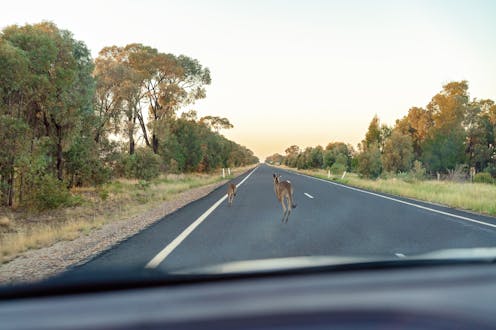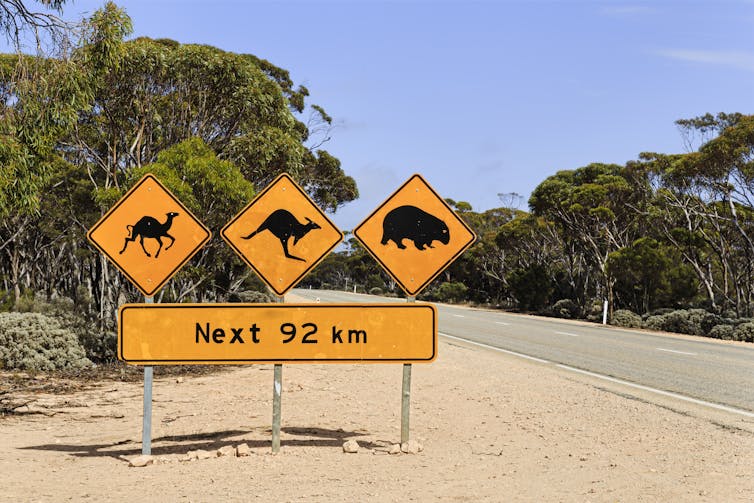Source: The Conversation (Au and NZ) – By Graeme Coulson, Honorary Principal Fellow, School of BioSciences, The University of Melbourne

There’s almost no warning. A dark shape appears on the side of the road, then you feel a jolt as something goes under the car. Or worse, the shape rears up, hits the front of your vehicle, then slams into the windscreen. You have just experienced a wildlife-vehicle collision.
This gruesome scene plays out every night across Australia.
When these collisions happen, many animals become instant roadkill. An estimated 10 million native mammals, reptiles, birds and other species are killed each year.
Others are injured and die away from the road. Some survive with terrible injuries and have to be euthanised. The lucky ones might be rescued by groups such as Wildlife Rescue, Wildlife Victoria and WIRES.
Wildlife-vehicle collisions also increase the risk to whole populations of some threatened species, such as Lumholtz’s tree-kangaroo on the Atherton Tablelands in Queensland.
People are affected, too. Human deaths and injuries from these collisions are rising, with motorcyclists at greatest risk. Vehicle repairs are inconvenient and costly. Added to this is the distress for people when dealing with a dead or dying animal on the roadside.
How can we reduce the wildlife toll on our roads? Many measures have been tried and proven largely ineffective. However, other evidence-based approaches can help avoid collisions.
Read more:
2 biggest threats to wombats revealed in new data gathered by citizen scientists
Evidence for what works is limited
Many communities are worried about the growing impacts of wildlife-vehicle collisions and are desperate for solutions. Recent reports from Europe and North America review the many methods to reduce such collisions.
Do these findings apply to Australia’s unique fauna? Unfortunately, we don’t have a detailed analysis of options for our wildlife, but here’s what we know now.
Well-designed fences keep wildlife off our highways but also fragment the landscape. Happily, animals will use crossing structures – overpasses and underpasses – to get to food and mates on the other side of the road. Fences and crossings do work, but are regarded as too costly over Australia’s vast road network.
As for standard wildlife warning signs, drivers ignore most of them after a while, making them ineffective. Signs with graphic images and variable messages get more attention, but we need road trials to assess their effect on drivers and collision rates.

Taras Vyshnya/Shutterstock
Read more:
Good news: highway underpasses for wildlife actually work
Whistling in the dark
Some drivers install cheap, wind-driven, high-pitched wildlife whistles on their vehicles. Tests in the United States 20 years ago found humans and deer could not hear any whistling sound above the road noise of the test vehicle. Yet these devices are still sold in Australia as kangaroo deterrents.
The Shu-Roo, an Australian invention, is an active wildlife whistle. It is fitted to the bumper bar, producing a high-pitched electronic sound, which is claimed to scare wildlife away from the road. Sadly, our tests show the Shu-Roo signal can’t be heard above road noise 50 metres away and has no effect on captive kangaroo behaviour.
We also recruited fleets of trucks, buses, vans, utes and cars to field test the Shu-Roo. Nearly 100 vehicles covered more than 4 million kilometres across Australia over 15,500 days. The drivers reported just over one wildlife-vehicle collision per 100,000km travelled, but there was no difference in the rate for vehicles fitted with a Shu-Roo versus those without one.
The virtual fence is the latest attempt to reduce wildlife-vehicle collisions. It uses a line of posts spaced along the roadside, each with a unit producing loud sounds and flashing lights aimed away from the road. Vehicle headlights activate the units, which are claimed to alert animals and reduce the risk of collision.
Early results from Tasmania were encouraging. A 50% drop in possum and wallaby deaths was reported, but this trial had many design flaws. Recent trials in Tasmania, New South Wales and Queensland show no effect of virtual fencing on collisions with possums, wallabies or wombats.
Our concern is that this system is being rolled out in many parts of Australia. It gives the impression of action to reduce collisions with wildlife, but without an evidence base, solid study design or adequate monitoring.
Read more:
Roadkill: we can predict where animals cross roads – and use it to prevent collisions
A very messy problem
The problem has many dimensions. We need to consider all of them to achieve safe travel for people and animals on our roads.
At a landscape level, collision hotspots occur where wildlife frequently cross roads, which can help us predict the collision risk for species such as koalas. But the risk differs between species. For example, on Phillip Island most wallaby collisions happen on rural roads, while most involving possums and birds are in urban streets.
Traffic volume and speed are key factors for many species, including kangaroos.
Driver training and experience are also important. In the Royal National Park in New South Wales, half the drivers surveyed had struck animals, including wallabies and deer. Yet most still weren’t keen to slow down or avoid driving at dawn and dusk.
Road design has a major influence on wildlife-vehicle collions too, but the planning process too often neglects wildlife studies.
Smarter cars are being developed. One day these will use AI to spot animal hazards, apply automatic emergency braking and alert other drivers of real-time risk.
To explore potential technological solutions, Transport for NSW is running a symposium at the University of Technology Sydney on May 21. The symposium will cover wildlife ecology and the evidence base for options to reduce wildlife-vehicle collisions in Australia.
If you see an injured animal on the road, call Wildlife Rescue Australia on 1300 596 457. for specific state and territory numbers, go to the RSPCA injured wildlife site.
![]()
Graeme Coulson currently receives funding from Nakatomi, Parks Victoria, Phillip Island Nature Parks and ACT Environment, Planning and Sustainable Development Directorate.
Helena Bender received past funding from the following organisations to undertake PhD research that is drawn up and reported in this work: Holsworth Wildlife Fund, The Royal Automative Club of Victoria, New South Wales Road Traffic Authority, National Roads and Motorists’ Association Limited, Transport South Australia, The University of Melbourne (Department of Zoology and the Faculty of Science). She has received funding more recently from Nakatomi.
– ref. 10 million animals die on our roads each year. Here’s what works (and what doesn’t) to cut the toll – https://theconversation.com/10-million-animals-die-on-our-roads-each-year-heres-what-works-and-what-doesnt-to-cut-the-toll-222367







